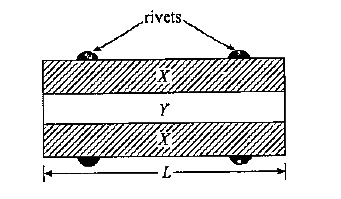PRACTICE EXERCISE from GK PUBLICATIONS PHYSICS (HINGLISH) HEAT AND THERMAL EXPANSION for Class 12
| Class 12 | PHYSICS |
| Chapter | HEAT AND THERMAL EXPANSION |
| GK PUBLICATIONS PHYSICS (HINGLISH) | PRACTICE EXERCISE |
| Medium | English |
| Academic Year | 2023-2024 |
Question 7
In the construction of a flyover, steel girders of length 12 m are used to place one after another. How much gap should be left between the two at their junction so that in summers whenpeak temperature is about 48∘C, there should not be any compresion. Given that the construction is done in peak winters when temperature is 18∘C. Given that the coefficient of linear expansion of steel is 1.1×10−5.∘C−1.View SolutionQuestion 9
Figure shows a steel rod of cross sectional ara 2×10−6m2 is fixed between two vertical walls. Initially at 20∘C there is no force between the ends of the rod and the walls. Find the force which the rod will exert on walls at 100∘C. Given that the coefficient of linear expansion of steel is 1.2×10−5.∘C−1 and Young's modulus is 2×1011N/m2
 View Solution
View SolutionQuestion 10
A glass window is to be fit in an aluminium frame. The temperature on the working day is 40∘C and the glass window measures exact 20cm×30cm. What should be the size of the aluminium frame so that there is no stress on the glass in winter even if the temperature drops to 0∘C? Coefficients of linear expansion for glass and aluminium are 9.0×10−6∘C−1 respectively.View SolutionQuestion 11
A cylindrical steel component machined on an engine lathe is heated to temeprature of 80∘C.The diameter of the component should be 5 cm at temperature of 10∘C and the permissible error should not exceed 10 microns from the specified dimension. Do we need correctionis for the thermal expansioni component be introduced during the process of machining ? If so what diameter should be prepared? Take αsteel=12×10−6.∘C−1.View SolutionQuestion 14
The time period of a physical pendulum is given by T=2π√Imgl. Where m= mass of the pendulum I= moment of inertia about the axis of suspension, l= distance of centre of mass of bob from the centre of suspension. Calculate the change in time period when temperature changes by ΔT. The coefficient of linear expansion of the material of pendulum is α. View SolutionQuestion 15
Two rods of material X sandwich another rod of material Y as shown in figure. At temperature t, the three rods are in a state of zero strailn and of length L and riveted to each other in this state. If the temperature of the system increases to T+ΔT, find the final length of the system of the three rods. Given that the coefficients of linear expansions of the roods and their Young's modulus for material X and Y are alpnax,αy,Yx and Yy respectively. Consider αy>αx.
 View Solution
View SolutionQuestion 16
In a mercury in glass thermometer the cross section of the capillary is A0 and volume of the bulb is V0 at 0∘C. If mercury just fills the bulb at 0∘C, find the that the length of mercury in the capillary at temperature t.∘C. Given that β=coefficient of cubical, expansion on mercury and α= coefficient of linear expansion of glass.View SolutionQuestion 17
A 1-L flask contains some mercury. It is found that at different temperature, the volume of air inside the flask remains the same. What is the volume of mercury in the flask, given that the coefficient of linear expansion of glass=9×10−6/∘C and the coefficient of volume expansion of Hg=1.8×10−4/∘C ?View SolutionQuestion 18
Some steem balls are fixed at the bottom of a silica bulb of negligible exapnsivity. The bulb holds 340 gm of mercury at 0∘C when filled, in the absence of the steel balls and 255 gm of mercyr, when the steel balls are inside. On heating the bulb and its contents (steel balls and mercury) to 100∘C, 4.5 gm of mercury overflows. Find the coefficient of linear expansion of steel. γHg=180×10−6.∘C−1View SolutionQuestion 20
In observing thereal expansion of a liquid a certain part of glass vessel is to be filled with a liquid of volume expansion γ=18×10−5 in order to exclude the effect of the change in remaining volume of the vessel during heating. What fraction of the vessel should be filled wiht the liquid? The coefficient of linear expansion of glass is =9.0×10−6.View SolutionQuestion 24
A small quantity of a liquid which dows not mix with water sinks to the bottom at 20∘C, the densities of the liquid and water being 1021 and 990kg/m3, respectively. To what teperature must the mixture be uniformly heated in order that the liquid forms globules which just float on water ? the cubical expansion of the liquid and water over the temperature ranges is 85×10−5/K and 45×10−5/K respectively. View SolutionQuestion 25
A can of water of volume 0.5m3 at a temperature 30∘C is cooled to 15∘C. Neglect heat capacity of the can. If the amount of heat released by water is used to a box of weight 10 kg, find the height to whilch it can be lifted. Given that specific theat of water is 4200J/kg.∘C. Take g=10m/s2.View SolutionQuestion 28
When a 290gm piece of iron at 180∘C is placed in a 100gm aluminium calorimeter cup containing 250gm of glycerin at 10∘C, the final temperature is observed to be 38∘C. What is the specific heat of glycerin? Use specific heat of iron 470 J/k K and that of aluminium is 900 J/kg K.View SolutionQuestion 30
A certain calorimeter has a water equivalent of 4.9 gm. That is in heat exchanges, the calorimeter behaves like 4.9 gm of water. It contains 40 gm of oil at 50.0∘C. When 100 gm of lead at 30.0∘C is added, the final temperature is 48.0∘C. What is the specific heat capacity of the oil?
[Take Swater=1cal/gm.∘C,Slead=0.305cal/gm.∘C]View SolutionQuestion 34
In a mixture of 35g of ice and 35g of water in equilibrium, 4gm steam is passed. The whole mixture is in a copper calorimeter of mass 50g. Find the equilibrium temperature of the mixture. Given that specific heat of water is 4200 J/kg K and that of copper is 420 J/Kg K and latent heat of fusion of ice is 3.36×105 J/kg and latent heat of vaporization of water is 2.25×106 J/kg.View SolutionQuestion 35
A lead bullet just melts when stopped by an obstacle. Assuming that 25 per cent of the heat is absorbed by the obstacle, find the velocity of the bullet if its initial temperature is 27∘C . (Melting point of lead =327∘C, specific heat of lead =0.03cal/g.∘C, latent heat of fusion of lead =6cal/g,J=4.2J/cal).View SolutionQuestion 36
Aluminium container of mass of 10 g contains 200 g of ice at−20∘C. Heat is added to the system at the rate of 100 calories per second. What is the temperature of the system after four minutes? Draw a rough sketch showing the variation of the temperature of the system as a function of time . Given:
Specific heat of ice = 0.5calg−1(.∘C)−1
Specific heat of aluminium = 0.2calg−1(.∘C)−1
Latent heat of fusion of ice = 80calg−1View SolutionQuestion 37
1 kg of ice at 0∘C is mixed with 1 kg of steam at 100∘C. Find the equilibrium temperature and the final composition of the mixture. Given that latent heat of fusion of ice is 3.36×105 J/kg and latent heat of vaporization of water is 2.27×106 J/kg. Specific heat of water is 4200J/kg.∘C−1View SolutionQuestion 38
When a block of metal of specific heat 0.1cal/g/∘C and weighing 110 g is heated to 100∘C and then quickly transferred to a calorimeter containing 200g of a liquid at 10∘C, the resulting temperature is 18∘C. On repeating the experiment with 400 g of same liquid in the same calorimeter at same initial temperature, the resulting temperature is 14.5∘C. find
a. Specific heat of the liquid.
b. The water equivalent of calorimeter.View SolutionQuestion 39
A pitcher contains 10 kg of water at 20∘C. Water comes to its outer surface through its porus walls and gets eveaporated. The latent heat required for evaporation is taken from the water inside the pithcer, thus the inside water is cooled down. It is given that the rate of evaporation is 0.2 g/s. Calculate the time in which the temperature of the water inside drops is 15∘C. Given that the specific heat of water is 4200J/kg∘C and latent heat of vaporization of water is 2.27×106 J/kg.View SolutionQuestion 40
A pitcher contains 1 kg water at 40∘C. It is given that the rate of evaporation of water from the surface of pitcher is 50 gm/s. Find the time it will take to cool down the water inside to 30∘C. Given that latent heat of vaporization of water is 540 cal /g and specific heat of water is 1cal/g.∘C.View Solution